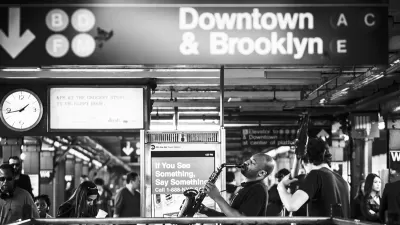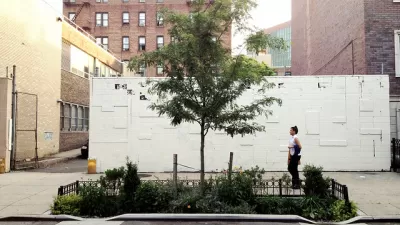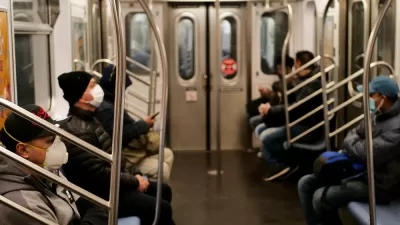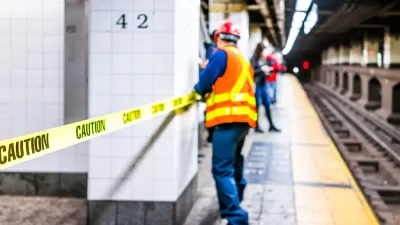While the New York subway's need for infrastructure investment is well documented, it was an improperly placed rail that caused two subway cars to derail on a southbound A train on Tuesday morning in Harlem.

The Metropolitan Transportation Authority "is now checking rails across the system to make sure replacement parts are being properly stored," report Jonathan Wolfe and Emma G. Fitzsimmons for The New York Times in one of several articles on the June 21 derailment.
The accident, which left at least 34 people injured [Planetizen put the number at 37] took place between the 135th Street and 125th Street stations. Two cars jumped the tracks after the emergency brakes were activated, officials said.
Human error was also the cause of a derailment almost two decades ago, on July 3, 1997, that occurred on the A Train line injuring 13 passengers and two firefighters.
A southbound A train jumped the track as it passed through 135th Street station at St. Nicholas Avenue. A worker who was fixing the switches at the station had accidentally flipped a switch for the wrong track.
The derailment added a new dimension to the concerns of the almost six million weekday commuters who rely on the nation's largest subway. "Until Tuesday, the main concern for riders had been long and unpredictable delays in a fraying system," report Fitzsimmons and Marc Santora in an earlier piece. "But in a flash, the concern shifted from inconvenience to questions about basic safety."
While human error was the cause of these two derailments, aging equipment in the 112-year-old system is causing delays plaguing every line. However, "it is not the No. 1 reason," report Fitzsimmons, Ford Fessenden, and K.K. Rebecca Lai in a related article.
The major cause of subway delays is a factor that basically did not exist 15 years ago: overcrowding. The subway is a victim of its own success and the city's resurgence. Large crowds slow down trains, which creates more crowding in a vicious circle that takes hours to unwind during every rush.
The article has a chart showing delays attributed to overcrowding, track maintenance, and signal failures or other track problems. The reporters chronicle the increase in subway ridership, which has reached "the highest level since the 1940s."
FULL STORY: New York Today: Derailment Answers and Your Commute

Alabama: Trump Terminates Settlements for Black Communities Harmed By Raw Sewage
Trump deemed the landmark civil rights agreement “illegal DEI and environmental justice policy.”

Planetizen Federal Action Tracker
A weekly monitor of how Trump’s orders and actions are impacting planners and planning in America.

The 120 Year Old Tiny Home Villages That Sheltered San Francisco’s Earthquake Refugees
More than a century ago, San Francisco mobilized to house thousands of residents displaced by the 1906 earthquake. Could their strategy offer a model for the present?

In Both Crashes and Crime, Public Transportation is Far Safer than Driving
Contrary to popular assumptions, public transportation has far lower crash and crime rates than automobile travel. For safer communities, improve and encourage transit travel.

Report: Zoning Reforms Should Complement Nashville’s Ambitious Transit Plan
Without reform, restrictive zoning codes will limit the impact of the city’s planned transit expansion and could exclude some of the residents who depend on transit the most.

Judge Orders Release of Frozen IRA, IIJA Funding
The decision is a victory for environmental groups who charged that freezing funds for critical infrastructure and disaster response programs caused “real and irreparable harm” to communities.
Urban Design for Planners 1: Software Tools
This six-course series explores essential urban design concepts using open source software and equips planners with the tools they need to participate fully in the urban design process.
Planning for Universal Design
Learn the tools for implementing Universal Design in planning regulations.
Clanton & Associates, Inc.
Jessamine County Fiscal Court
Institute for Housing and Urban Development Studies (IHS)
City of Grandview
Harvard GSD Executive Education
Toledo-Lucas County Plan Commissions
Salt Lake City
NYU Wagner Graduate School of Public Service





























